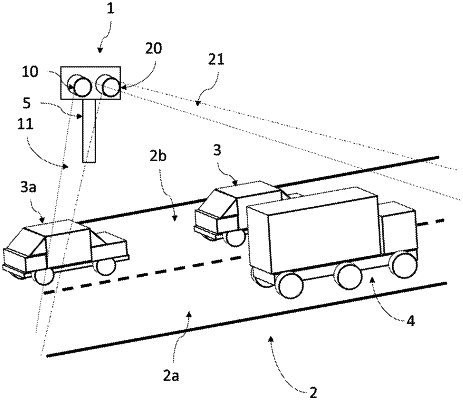| CPC G01S 13/931 (2013.01) [G06V 20/58 (2022.01); G01S 2013/932 (2020.01); G01S 2013/9325 (2013.01)] | 8 Claims |

|
8. A system for monitoring vehicles comprising at least one radar sensor and a second remote sensor different from the radar sensor, the second remote sensor being an optical sensor, said optical sensor being a time-of-flight optical sensor or an optical image sensor, the system for monitoring vehicles being configured to be arranged in a fixed manner in the vicinity of a road comprising at least two traffic lanes, the radar sensor being configured to operate over a radar detection range of the road covering at least two traffic lanes and to emit a stream of radar data representative of the detection of vehicles on the road, the optical sensor being configured to operate over a second detection range of the road covering at least two traffic lanes and to emit a second stream of optical data representative of the detection of vehicles on the road, the radar detection range and the second detection range being at least partially superimposed,
wherein the second remote sensor is an optical sensor emitting a stream of optical data representative of the detection of vehicles on the road, said optical sensor being a time-of-flight optical sensor or an optical image sensor,
the system for monitoring vehicles further comprising a processor, said processor being configured to, in a continually repeated manner for a plurality of successive frames:
a) temporally readjust and spatially match in a fixed shared spatial marker of the radar data from the radar sensor and of the optical data from the optical sensor in order to obtain a set of measurement points each assigned with first characteristics derived from the radar data, the first characteristics comprising position measurements and speed measurements, and second characteristics derived from the optical data, the second characteristics comprising at least position measurements,
b) determine radar vehicle trackings from the first characteristics derived from the radar data from the radar sensor and optical vehicle trackings from the second characteristics derived from the optical data from the optical sensor, wherein:
b1) a first segmentation which groups together, in first clusters, measurement points having first characteristics derived from radar data evolving in a similar way over several consecutive frames, the following over time of a first cluster forms a radar vehicle tracking,
b2) a second segmentation which groups together, in second clusters, measurement points having second characteristics derived from optical data evolving in a similar way over several consecutive frames, the following over time of a second cluster forms an optical vehicle tracking,
c) compare a similarity between the radar vehicle trackings and the optical vehicle trackings, wherein said comparison is based at least on the presence of shared measurement points over several consecutive frames in said radar vehicle tracking and said optical vehicle tracking, and a match of similar radar and optical vehicle trackings,
d) eliminate the radar vehicle trackings for which no optical vehicle tracking is similar, in order to retain only the radar vehicle trackings for which at least one optical vehicle tracking is similar,
the processor being further configured to:
e) monitor a parameter derived from first characteristics derived from radar data from radar sensor and corresponding to measurement points of a retained radar vehicle tracking for which an optical vehicle tracking is similar, and
when an optical vehicle tracking does not have any similar radar vehicle tracking after the comparison of similarity between the radar vehicle trackings and the optical vehicle trackings, to monitor a parameter derived from first characteristics derived from radar data from the radar sensor and corresponding to measurement points of the second cluster of said optical vehicle tracking which does not have a similar radar vehicle tracking.
|